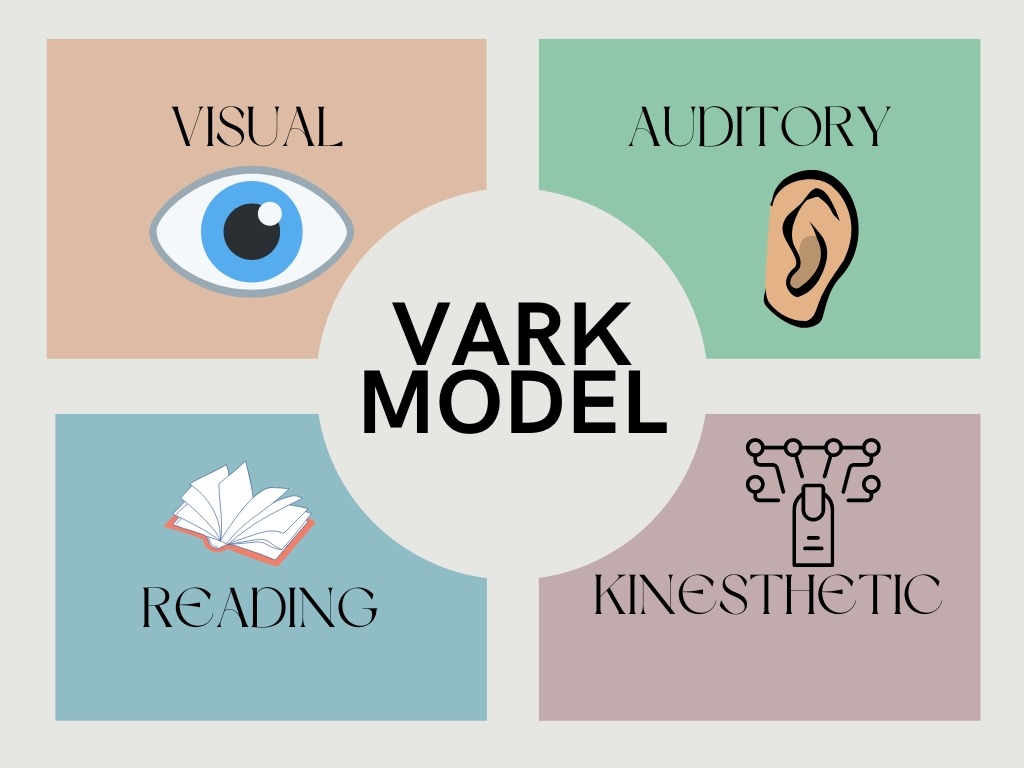VARK Model: Introduction
The VARK model of learning and development is a framework designed to help individuals understand their preferred learning styles. VARK stands for Visual, Auditory, Reading/Writing, and Kinesthetic. According to this model, everyone has a dominant learning style, which can be one or a combination of these four types. It is a part of the detailed coverage of 13 Learning and Development Models which you must know as an Educator or an L&D Manager.
The VARK model is founded by Neil Fleming, a New Zealand teacher and education consultant, in 1987. The VARK scale is a questionnaire designed to identify an individual’s preferred learning style. It consists of 16 multiple-choice questions that assess the respondent’s preferences for visual, auditory, reading/writing, and kinesthetic learning styles.
Despite its popularity, the VARK model has received criticism from some educators and researchers who believe that the learning styles theory has limited scientific evidence. Critics argue that the model does not account for the complexity of learning and that individuals may have multiple learning styles that change over time.
VARK Model: What are the 4 types of learning?

Visual learners prefer to learn through pictures, diagrams, and other visual aids. They can easily understand concepts by seeing them. Auditory learners, on the other hand, learn best through hearing and listening. They can grasp ideas through lectures, discussions, and music. Reading/Writing learners prefer to learn through the written word. They enjoy reading, writing, and taking notes. Lastly, kinesthetic learners prefer to learn by doing. They learn best by engaging in hands-on activities and experiments. All these comprise of the VARK Model
| Learning Style | Description | Preferred Mode of Learning | Examples of Best Training Modes |
| Visual | Learns through visual aids such as pictures and diagrams | Seeing and observing | Videos, diagrams, charts, infographics, mind maps |
| Auditory | Learns through listening and hearing | Participating in discussions, lectures, and music | Lectures, podcasts, audiobooks, group discussions, interviews |
| Reading/Writing | Learns through the written word | Reading, writing, and taking notes | Textbooks, manuals, handouts, note-taking, writing exercises |
| Kinesthetic | Learns through hands-on activities and experimentation | Doing and engaging in hands-on activities | Simulations, experiments, field trips, hands-on exercises, role-playing |
How do you use VARK in the classroom?
The VARK model is important because it helps educators tailor their teaching methods to suit the learning styles of their students. By understanding their preferred learning style, students can improve their academic performance, retain information more effectively, and develop their skills more efficiently. Teachers can use VARK to design their lesson plans, materials, and assessments that cater to the individual learning styles of their students.
To use the VARK model in the classroom, teachers can incorporate different teaching strategies and materials that cater to the learning styles of their students. For visual learners, teachers can use images, videos, and diagrams. For auditory learners, teachers can use lectures, discussions, and podcasts. For reading/writing learners, teachers can provide written materials, handouts, and assignments. For kinesthetic learners, teachers can use experiments, group activities, and hands-on projects.
VARK Model Questionaire
- When learning about a new legal concept, I prefer to: | Look at diagrams or charts that explain the concept. | Listen to a lecture or discussion about the concept. | Read an article or textbook chapter about the concept. | Participate in a mock trial or case study that applies the concept.
- When preparing for a legal presentation, I like to: | Use visual aids such as PowerPoint slides or infographics. | Rehearse my presentation out loud. | Create an outline or script for my presentation. | Practice delivering my presentation with a colleague or in front of a mirror.
- When reviewing legal documents, I prefer to: | Use color coding or highlighting to organize information. | Discuss the content with a colleague or mentor. | Take detailed notes or make annotations on the document. | Act out scenarios or use role-play to apply the information.
- When learning about changes to legal regulations, I prefer to: | See a visual timeline or flowchart of the changes. | Listen to an expert explain the changes in a meeting or webinar. | Read a summary or analysis of the changes in a report or article. | Engage in a group discussion or debate about the changes.
- When learning new legal skills, I like to: | Watch a video tutorial or demonstration of the skill. | Listen to an audio recording or podcast about the skill. | Read a how-to guide or instruction manual for the skill. | Practice the skill in a simulated or real-world scenario.
This questionnaire is tailored to the specific learning preferences of mid-level executives in a legal firm. It assesses their preferences for the four learning styles of the VARK model: visual, auditory, reading/writing, and kinesthetic. Each question offers four options, one for each learning style, and the respondent selects the option that best describes their preferred way of learning. At the end of the questionnaire, the respondent’s scores for each learning style are tallied, and they can determine their dominant learning style(s).
In summary, the VARK model is a useful tool for understanding an individual’s preferred learning style. It can help educators tailor their teaching methods to suit the learning styles of their students, thereby improving their academic performance and skill development. However, it is important to note that the VARK model is not without its criticisms, and educators should use it in conjunction with other theories and approaches to teaching and learning.
Samrat is a Delhi-based MBA from the Indian Institute of Management. He is a Strategy, AI, and Marketing Enthusiast and passionately writes about core and emerging topics in Management studies. Reach out to his LinkedIn for a discussion or follow his Quora Page
